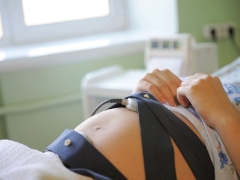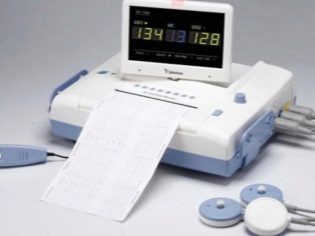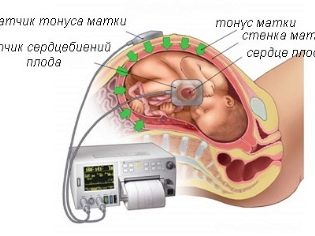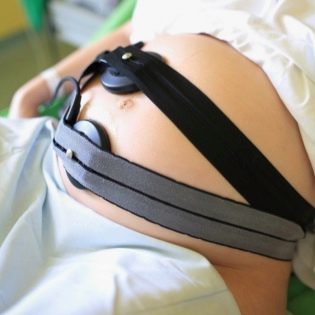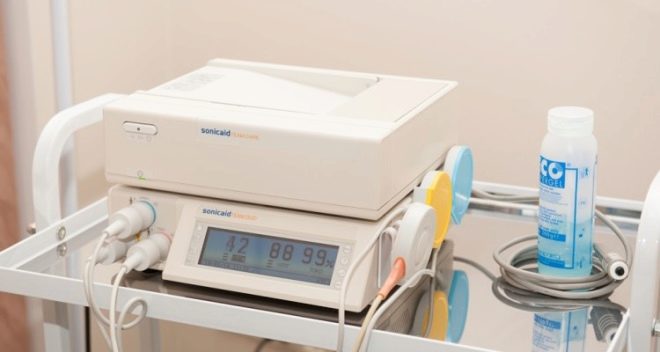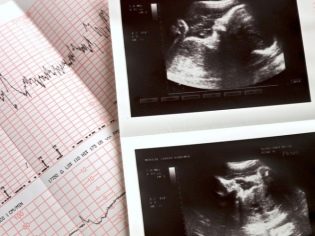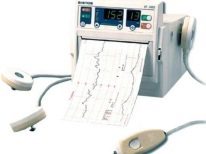How can CTG detect contractions?
Assess the vitality and condition of the baby before childbirth is very important. This will help doctors orient themselves with the choice of tactics for proper obstetric aid. It is possible to assess the condition of the baby and promptly identify the approaching contractions in the mother with the help of cardiotography.
What does the method show?
This study is very popular in many countries. Such popularity is not accidental. With the help of this survey, doctors get quite a lot of information they need about how the baby feels. They evaluate his heartbeat, motor activity, and also determine how much the mother's uterine walls are reduced.
This examination is not invasive. For its implementation is not required to conduct any surgical techniques. The survey does not give the future mother and her baby any anxiety and does not carry danger. Such features of the method and served as its strong popularity.
Cardiotocography (CTG) can be performed at different periods of prenatal development of the baby. It helps to assess the presence of dangerous complications during pregnancy. Also, this study can be done immediately before a pregnant woman is about to give birth. According to certain changing indicators, it is possible to assess the presence of contractions.
In some cases, this method is carried out directly during childbirth. It helps doctors keep track of how birth goes.
If during the passage of the baby through the birth canal, cardiotocography indices significantly deviate from the maximum permissible, then this may lead to a change in the choice of tactics. In such a situation, a woman will undergo a caesarean section.
What indicators are used?
To assess the condition of the baby, several parameters are evaluated at once. This allows doctors to make a comprehensive assessment of the child's well-being.
The main parameter that is monitored during this method is the baby's heartbeat. Throughout pregnancy, this indicator varies significantly.
As the baby grows, the work of its cardiovascular system changes. This is due to the fact that for active growth and development it needs chemicals and oxygen. They are carried by the blood. For normal blood flow and a sufficient amount of heartbeat is required.
In various pathologies, the number of contractions of a child's heart may vary. Often, the development of such an adverse symptom leads to hypoxia. In this case, the flow of essential nutrients for the functioning of the child is significantly reduced.
To measure this indicator, special sensors are used. They are fixed on the belly of the expectant mother. Its best position in the measurement of this indicator - lying on the couch on your back or side. Sensors can also be fixed during physiological (real) or training fights.
A woman herself participates in the research process. She needs to press the device button in the event that she felt the active movement of the child. During labor, such a study helps the doctor understand how the child is suffering.
Currently, doctors are trying to perform cardiotocography during the entire period of labor. This helps doctors get information about how the child feels during active labor activity.
Immediately it is worth noting that such studies are performed during all births. not in every medical institution. Much depends on what level of material and technical base it has.
However, such studies are very important in childbirth for all women who are in risk groups for developing dangerous pathologies of labor. As a rule, many of them give birth in specialized perinatal centers or specialized maternity hospitals.
Using this method, you can also determine the intensity of contractions. Doctors evaluate the strength of contractions using several clinical parameters. Such an assessment, which may be excessive or, conversely, sharply weakened, helps specialists to establish various pathologies of labor activity in time.
If childbirth proceeds well, and the strength of contractions is within the normal range, then they simply continue to observe the condition of the baby before his birth.
How to determine the contractions?
Doctors can identify the beginning labor activity with the help of special devices on which the research is conducted. Before the start of the survey, the initial data of the patient must be entered. It is also important to fix the period when she has no uterine contractions. This kind of bottom line will be the reference point of the study.
Experts point out that All abbreviations begin in the bottom area of the reproductive organ. In this place and recorded sensors. This is necessary so that all arising pulses are well displayed on the monitor of the device or on film.
The process of general contraction is ensured by the sequential contraction of each individual muscle fiber. As soon as the entire uterine wall contracts and reaches the bottom, this is displayed on the monitor screen.
The changing pattern gives the doctors information that contractions begin. During such an episode, they estimate its duration as well as intensity. All indicators are recorded. During labor, the assessment of the dynamics of contractions is very important. With this method you can identify not only real, but also training uterine contractions.
Such contractions appear more in the second half of the intrauterine development of the baby, as well as in the last weeks before the birth. They look like irregular cuts on the film or monitor. By the time they are not long.
Many future moms start to get very upset if the doctors have identified their training bouts. Worry about this is not worth it. This condition is physiological and is recorded in many women.
Such contractions of the uterus future mother, as a rule, can not be felt. However, some women still feel them. They may complain to their doctors about the appearance of a slight discomfort or “pulling” pain in the lower abdomen. During the examination, the doctor may reveal that the bottom of the uterus becomes more compacted.
This condition is also well defined using highly sensitive strain gauges. With their help, you can determine a small tension in the area of the bottom of the uterus, as well as a small increase in it in this area. In most cases, the duration of one such "training" episode lasts no more than 60-90 seconds.
How to decrypt correctly?
Decoding the values obtained is very important. It helps doctors assess the condition of the baby and the mother in a timely manner and, if necessary, quickly adjust the method of delivery.
If at the time of the study the contractility of the uterus is too strong, then it is usually accompanied by strong and painful contractions. The future mother is suffering such fights very hard.However, the benefits of them are few.
In the majority of cases, the cervix in such a state is very slow and does not open well. This situation against the background of active and stormy contractile activity of the uterus can lead to pathologies dangerous for the fetus.
In order to avoid this, doctors can introduce antispasmodics to the expectant mother. Often this means is Drotaverine Hydrochloride. It helps to "gently" open the cervix and significantly alleviate the generic activity, as well as the condition of the baby.
To evaluate the effectiveness of therapy can again be using CTG. In this case, during the next contractions, the device will show that the fetal heartbeat and its active motor activity are within the normal range.
In obstetric practice there are also opposite situations. They, on the contrary, are accompanied by a weakening of labor. This condition can also be seen with cardiotocography. First, as a rule, labor activity proceeds actively. Over time, it slowly begins to decrease.
The strength and frequency of contractions, which are determined using this method of research, begin to gradually decline. The time intervals between such contractions of the uterus are significantly increased.
The doctor during the development of this condition also assesses the time of the onset of labor and the general condition of the mother. Another important parameter to be evaluated is the dry period. This time since the discharge of amniotic fluid. It is his many mothers and consider the beginning of labor.
If the amniotic fluid has not yet come out, then lengthening the interstitial period is not a frighteningly dangerous condition. In this case, doctors, as a rule, give the woman a little rest. After him, the clan activity is resumed again, without any outside participation.
In order for a woman in labor to sleep a little, she may be given special medicinal substances. One of these drugs is "Promedol". The need for his statement is determined by an obstetrician-gynecologist who is giving birth to a specific woman.
A long anhydrous period on the background of impaired labor is a dangerous condition for the fetus. While the baby is standing in the uterus, the risk of hypoxia (oxygen starvation of tissues and organs) increases many times. Delay in the provision of medical care can even lead to a threat to the life of the child or to the development of pathologies and consequences dangerous to him.
It so happens that the future mother is hospitalized at the maternity hospital with suspicion of the onset of labor. In the emergency room of the hospital, the doctors do her cardiotocography, evaluate the contractions and understand that the birth process has not started at all.
There are also reverse situations. A woman at a late pregnancy comes to the appointment with her obstetrician for the purpose of another consultation. The doctor conducts her cardiotography and realizes that she has actively started labor.
Indeed, such situations are taking place. The fact is that the intensity of contractions can be different. Each woman suffers pain syndrome in different ways. The level of pain threshold (the ability to feel and feel pain) is individual for each individual. In this case, the expectant mother will be urgently hospitalized for delivery.
Many pregnant women worry about whether cardiotocography can harm the baby. Doctors believe that this study is absolutely safe. It is the safety method and allows it to be used before and during childbirth.
However, it is worth noting that the technique of conducting this survey is very important. Its violation not only can lead to false results, but can also contribute to causing traumatic injury to the fetus.
Usually such cases are extremely rare in medical practice. If the specialist conducting the research is sufficiently qualified and has clinical experience in conducting it, then you should not worry about the outcome.
